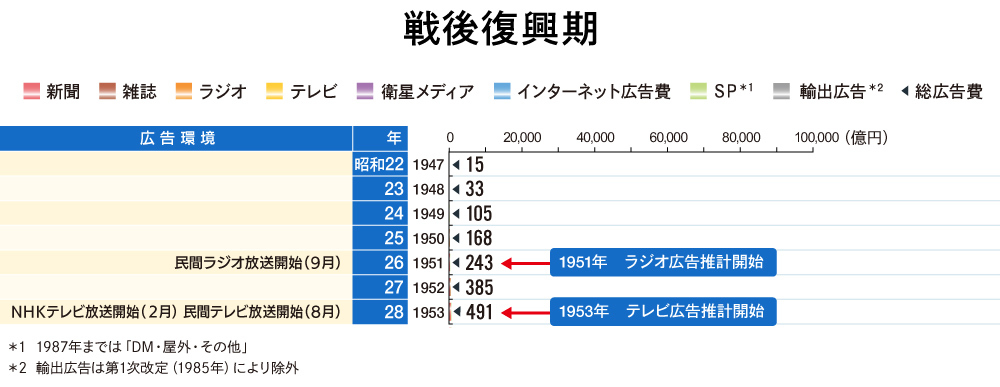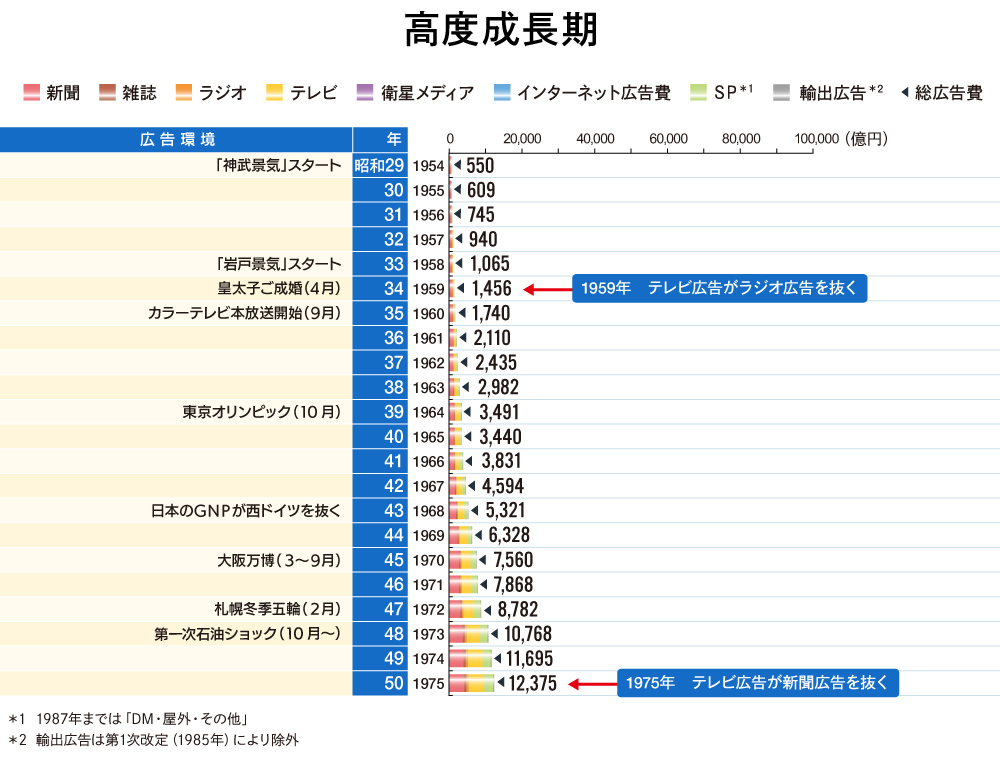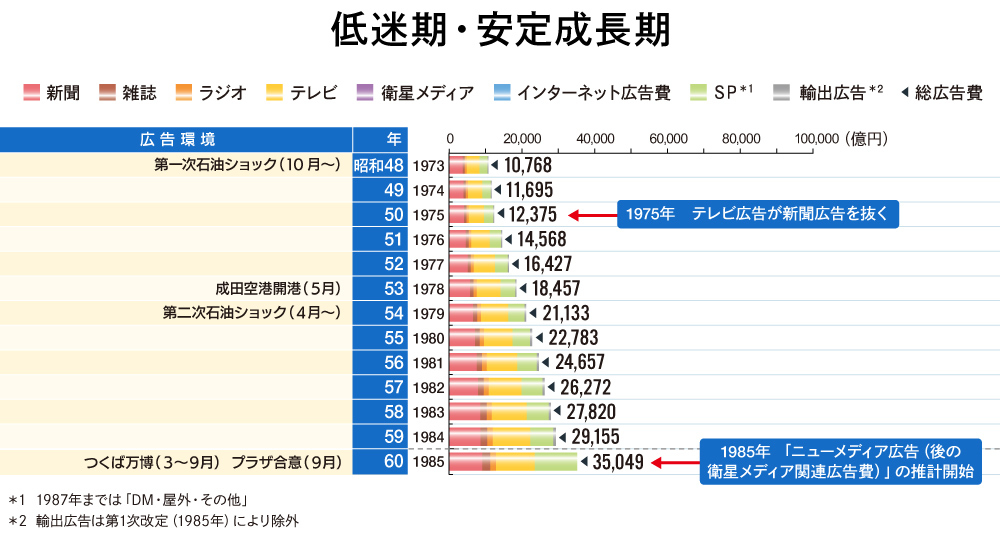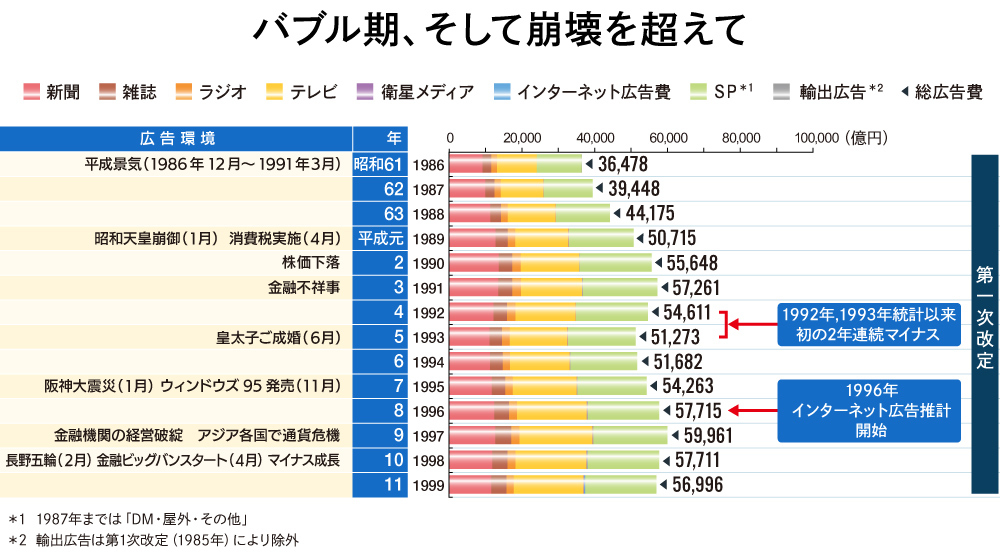This series introduces parts of the opening feature in the Dentsu Inc. Media Innovation Lab edition of the " Information Media White Paper 2023." This article, based on the feature "Japan's Advertising Expenditures: Reflecting on 75 Years," examines how postwar Japan's advertising spending has been influenced by economic and social conditions.
In 2022, Japan's advertising expenditure reached ¥7.1021 trillion, marking the highest level since estimates began in 1947. (※For details on estimation methods, see here ) This surpassed the previous record high of ¥7.0191 trillion set in 2007.
The 15 years since 2007 saw major events that shook the socio-economic landscape: the 2008 Lehman Shock, the 2011 Great East Japan Earthquake, and the spread of COVID-19 starting in 2020. Each time, Japan's total advertising expenditure underwent significant changes.
While 2022 saw various global uncertainties, such as the situation in Ukraine, which could have negatively impacted advertising spending, the gradual reduction in the societal impact of COVID-19 and the resulting modest economic recovery are considered key factors. Below, we trace the evolution of Japan's advertising expenditure since 1947.

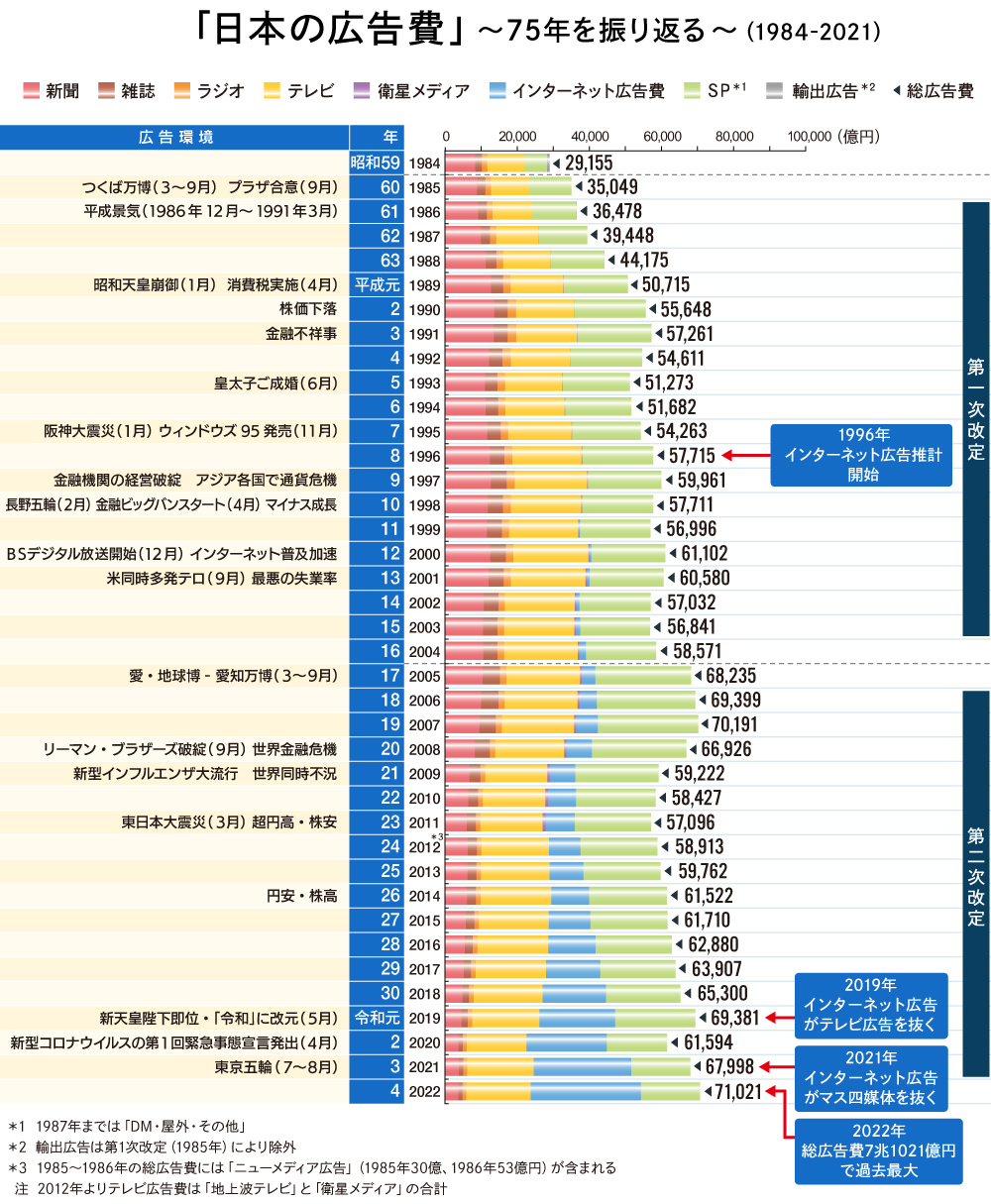
"Advertising is a mirror reflecting the times."
Dentsu Inc. has estimated and published "Japan's Advertising Expenditures" since 1947 (Showa 22). These figures aggregate advertising spending across media, allowing us to track the evolution of the advertising market since then. Advertising expenditure itself has been found to correlate strongly with "nominal GDP" (*1), meaning it is closely tied to economic trends. (Figure 1)
*1 = Nominal GDP
GDP calculated by multiplying the quantity of goods and services produced each year by their market prices. GDP calculated after removing the effects of price fluctuations is called "real GDP."
1947 was a period of chaos, with the entire nation exhausted and the scars of war still deeply visible. However, as the economy rapidly recovered through the postwar reconstruction period, people's lives became more affluent, and advertising expenditures grew steadily in step with this progress.
The government declared in its Economic White Paper that "the postwar period is over" in 1956, a statement based on the fact that the previous year's 1955 GDP had surpassed prewar levels. Advertising expenditure in 1955 also showed growth exceeding 40 times that of 1947. In this way, "Japan's advertising expenditure" can also be seen as a mirror reflecting the times.
[Postwar Reconstruction Period] Radio advertising spending grew over tenfold within three years of its introduction, while television, the "unattainable luxury," saw only gradual growth.
Before estimates of "Japan's Advertising Expenditures" began, the primary media the public encountered were newspapers and magazines. The first "Japan's Advertising Expenditures" published in 1947 showed newspapers at 1.1 billion yen, magazines at 160 million yen, and other advertising (including outdoor) at 200 million yen. The total was 1.46 billion yen. This marked the start of "Japan's Advertising Expenditures."
Radio was the first to be added. In April 1951, provisional licenses were granted to 16 private radio stations. Two stations began broadcasting in September, with four more launching by year-end. Radio advertising expenditure was ¥300 million in its inaugural year, 1951. However, the following year it surged to ¥2.2 billion, surpassing the ¥1.8 billion spent on magazine advertising that same year. By 1953, it had grown to ¥3.5 billion, a 1.6-fold increase, instantly establishing itself as a significant category within advertising expenditure.
Television broadcasting began two years later than radio, in 1953. NHK's television broadcasts started in February of that year, with commercial broadcasting commencing at the end of August.
Advertising expenditure in the inaugural year of 1953 was ¥100 million, rising to ¥400 million the following year and ¥900 million in the third year, 1955. This growth did not match the rapid surge seen in radio advertising. This is likely because while radio receivers had become relatively affordable, television sets remained prohibitively expensive, requiring more time for widespread adoption. On the other hand, the boom in street-side television viewing undoubtedly heightened the desire among consumers to eventually own a television set.
【High-Growth Era】The Surge in TV Advertising Spending! By 1975, it had grown to ¥420.8 billion, becoming the top mass media advertising category.
The "Jinmu Boom" starting in 1954 opened the door to the High Growth Era, and the subsequent "Iwato Boom" from 1958 propelled this period forward.
Televisions, washing machines, and refrigerators were called the "three sacred treasures." A boom swept the nation, with people aspiring to own them as symbols of affluence. The completion of Tokyo Tower in 1958 and the wedding of the Crown Prince and Princess (now the Emperor Emeritus and Empress Emerita) in 1959 became catalysts for television adoption, reaching a 90% household penetration rate by 1965.
Furthermore, the 1964 Tokyo Olympics and the 1970 Osaka Expo boosted color television adoption, with color TV household penetration exceeding 90% by 1975. Television advertising expenditure grew rapidly, mirroring the economic growth of the high-growth era. In 1959, it reached ¥23.8 billion, a 226.7% increase from the previous year, surpassing radio advertising expenditure of ¥16.2 billion that same year.
By 1975, it had grown to ¥420.8 billion, surpassing newspaper advertising expenditures of ¥409.2 billion that same year and leaping to the top position in mass media advertising.
[Slump Period / Stable Growth Period] Estimation of "New Media Advertising Expenditures" Begins Amid Media Diversification
The two oil crises of the 1970s and the Plaza Accord of 1985 brought the era of high economic growth to an end. Furthermore, the hollowing out of U.S. industry led to the emergence of various new services, significantly impacting the media world. This marked the arrival of the new media boom.
The launch of cable television (CATV), BS broadcasting, and CS broadcasting accelerated the spread of multi-channel services, including retransmission. In 1985, we began estimating "New Media Advertising Expenditures" as a separate category within Japan's advertising spending, later renamed "Satellite Media-Related Advertising Expenditures." New Media Advertising Expenditures in the first year of estimation were ¥3 billion, rising to ¥5.3 billion the following year, a 176.7% increase year-on-year.
Meanwhile, the 1980s saw advancements in communication networks. The spread of ISDN, the launch of services like teletext, the Captain System, and personal computer communications, and the increasing adoption of advertising models in these services all contributed to this trend. This movement would lead to the spread of the Internet in the 1990s.
[Beyond the Bubble Era and Its Collapse] The Internet Age Arrives in the Advertising World
Japan's economy experienced significant revitalization during the bubble economy period, said to have begun around 1986. Overall advertising expenditure showed high growth rates until the bubble burst in 1991. Newspaper advertising expenditure peaked at ¥1.3592 trillion in 1990. Conversely, immediately after the bubble burst, 1992 and 1993 recorded the first consecutive years of negative growth in the history of the "Japanese Advertising Expenditure" statistics.
The year 1995 saw the advent of Windows 95 and the beginning of widespread Internet adoption. Initially, connections were slow, but around the year 2000, the proliferation of ADSL lines led to a rapid expansion in Internet usage. Alongside this growth in Internet use, the "Japanese Advertising Expenditure" statistics began publishing estimates for Internet advertising spending starting in 1996. Internet advertising expenditure that year was ¥1.6 billion, but it surged to ¥6 billion the following year, a 375% year-on-year increase.
The Asian financial crisis began in 1997, causing overall advertising spending to decline year-on-year in 1998 and 1999, with other advertising categories also experiencing negative growth across the board. However, internet advertising spending continued to grow at around 200% year-on-year. It can be said that the internet era had arrived in the advertising world.
Surviving the Era of Low Growth and Various Economic Crises ~ Further Advancement of Digitalization ~
BS digital broadcasting commenced in December 2000, marking the start of the digital broadcasting era. Simultaneously, key networks entered the BS broadcasting market, initiating full-scale advertising campaigns.
Satellite media-related advertising spending in 2001 surged to ¥47.1 billion, a 177.1% year-on-year increase, reflecting high expectations for BS broadcasting. Digital terrestrial broadcasting commenced in the Tokyo-Osaka-Nagoya region in 2003, and the Nikkei Shimbun launched its digital edition in 2010, marking the advancement of media digitization. Simultaneously, mass media advertising spending began its decline.
Entering the 2000s, market economic fluctuations significantly impacted advertising spending: the collapse of the IT bubble in 2002, the global recession triggered by the 2008 Lehman Shock, the 2011 Great East Japan Earthquake, and the COVID-19 pandemic starting in 2020. However, while acknowledging changes and expansions in the scope of estimation, internet advertising spending alone has continued to grow positively, significantly contributing to the record-high advertising expenditure in Japan in 2022. Its share of total advertising spending now exceeds 40%.
This article has examined how Japan's postwar advertising expenditure has transformed in response to socio-economic conditions and the emergence of new media.
Next time, we plan to cover how advertising expenditures across the four major media outlets have changed alongside internet advertising, amid the spread of the internet and digitalization; how estimation methods for advertising expenditures have adapted as media and advertising evolve; and how advertising is likely to change going forward.





